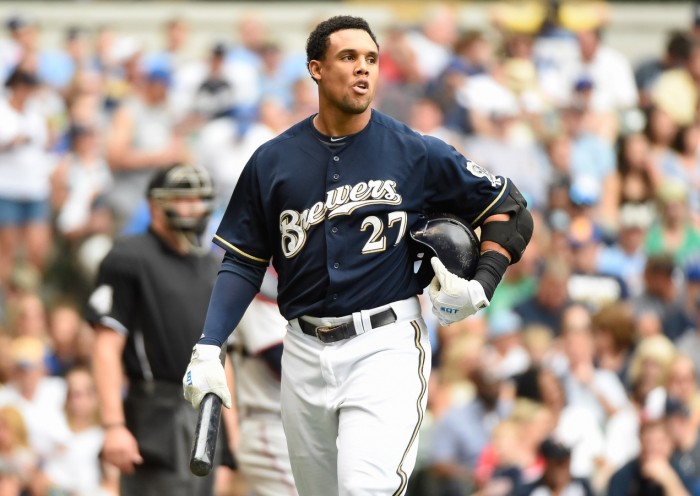Amid the many facets of Milwaukee’s disappointing season, Carlos Gomez has seemingly fallen from his lofty perch as one of baseball’s best outfielders. After topping 5.0 WARP in each of the past two seasons, he has currently compiled 1.1 WARP for 2015, while PECOTA only projects him to finish the year with a 2.7 WARP. That remains valuable, but no longer elite. And at age 29, it seems likely that he’ll cease to improve from this point in his career.
A few factors have precipitated this decline. Chiefly, he has lost much of the power production that he once provided the Brewers. Across the previous two seasons, he posted a .207 ISO. That has dropped to .159 this year. I could delve into the possible causes of that — the whole hip-injury thing generally doesn’t do wonders for a hitter’s swing — but I’d instead like to focus on its possible ramifications on another part of Gomez’s game, his walk rate. In his elite years, Gomez took free passes in a respectable 6.8 percent of his plate appearances. This season, though, that clip has descended to 3.8 percent, sucking the life out of his on-base percentage (and, consequently, his overall WARP).
When a hitter struggles at the plate, the thinking typically goes, he will begin to lose patience. He begins swinging at bad pitches more often, hoping to get himself going — in sports jargon, he’ll press. Breaking down Gomez’s peripherals, it’s clear that common aphorism has held true for him.
First, let’s look at counts with zero balls. In those, Gomez has not notably changed his plate discipline:
| Year(s) | O-Swing% (0 Balls) | Zone% (0 Balls) | xStr% (0 Balls) |
|---|---|---|---|
| 2013-2014 | 37.7% | 35.3% | 59.7% |
| 2015 | 38.3% | 29.9% | 56.8% |
Together with fewer pitches in the zone, Gomez has actually garnered more balls than usual in these counts. We see an even better trend for one-ball counts, in which his control of the zone has not only stayed the same, but has improved:
| Year(s) | O-Swing% (1 Ball) | Zone% (1 Ball) | xStr% (1 Ball) |
|---|---|---|---|
| 2013-2014 | 43.9% | 32.1% | 61.9% |
| 2015 | 39.0% | 31.8% | 58.4% |
Again, Gomez owns a lower strike rate in the present campaign than in past ones. With this seemingly bettered approach to guide him, why has Gomez taken fewer free trips to first?
It’s simple: From two balls on out, Gomez has crumbled. He’s offered at far more bad pitches in two-ball counts:
| Year(s) | O-Swing% (2 Balls) | Zone% (2 Balls) | xStr% (2 Balls) |
|---|---|---|---|
| 2013-2014 | 42.3% | 40.4% | 65.6% |
| 2015 | 60.6% | 21.8% | 69.2% |
And in three-ball counts:
| Year(s) | O-Swing% (3 Balls) | Zone% (3 Balls) | xStr% (3 Balls) |
|---|---|---|---|
| 2013-2014 | 47.7% | 47.4% | 72.5% |
| 2015 | 74.3% | 36.4% | 83.6% |
In the beginning of his at-bats, the numbers suggest that Gomez has kept his poise. Once he feels that he’ll get a pitch to hit, though, he completely abandons any semblance of a plan at the plate.
Following this exercise, of course, we arrive at the question of cause. The aforementioned hip ailment continues to hamper Gomez — it kept him out of the lineup until just last week — and unless he convalesces fully, the clout he displayed last year and the year prior probably won’t reappear. Should this occur, he’ll presumably remain an impatient hacker — albeit one with legitimate value — as he’s been thus far in 2015.
Gomez took a huge step forward with the Brewers a few years ago and sustained that success for far longer than most late-career breakouts last. No one could fault him for depreciating a bit in his late-20s, especially given the fact that he didn’t bring upon himself the (likely) impetus of his hard times. As he continues to age, though, he’ll have to play through more and more injuries, and his ability to adjust to that may determine the outcome of his career. If he keeps up this pace, it certainly won’t end well for him.
